Briggs & Stratton 1806, 1805 User Manual
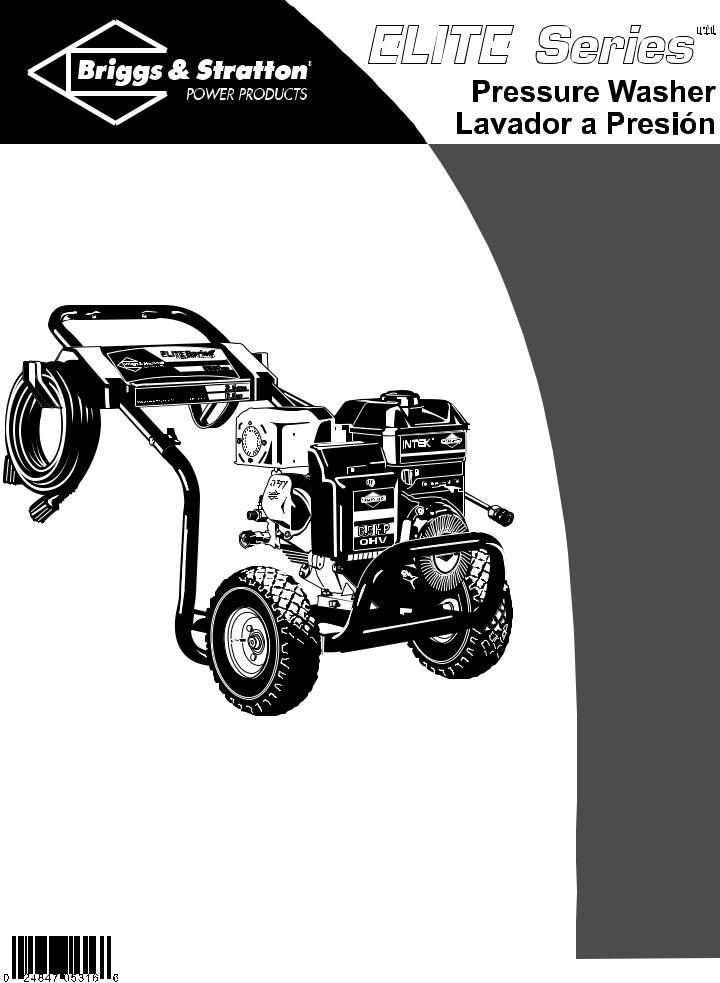
Model 01806 Shown
Owner’s Manual Manual del Propietario
01805
(2500 PSI)
01806
(2650 PSI)
01936
(2550 PSI)
Questions? Help is just a moment away!
Preguntas? La ayuda es justa un momento lejos!
Call: Pressure Washer Helpline - 1-800-743-4115 M-F 8-5 CT Llame: Línea Directa del Lavador a Presión - 1-800-743-4115 M-F 8-5 CT
& STRATTON POWER PRODUCTS GROUP, LLC
JEFFERSON,WISCONSIN, U.S.A.
Manual No. 191678GS
Revision 1 (03/03/2003)
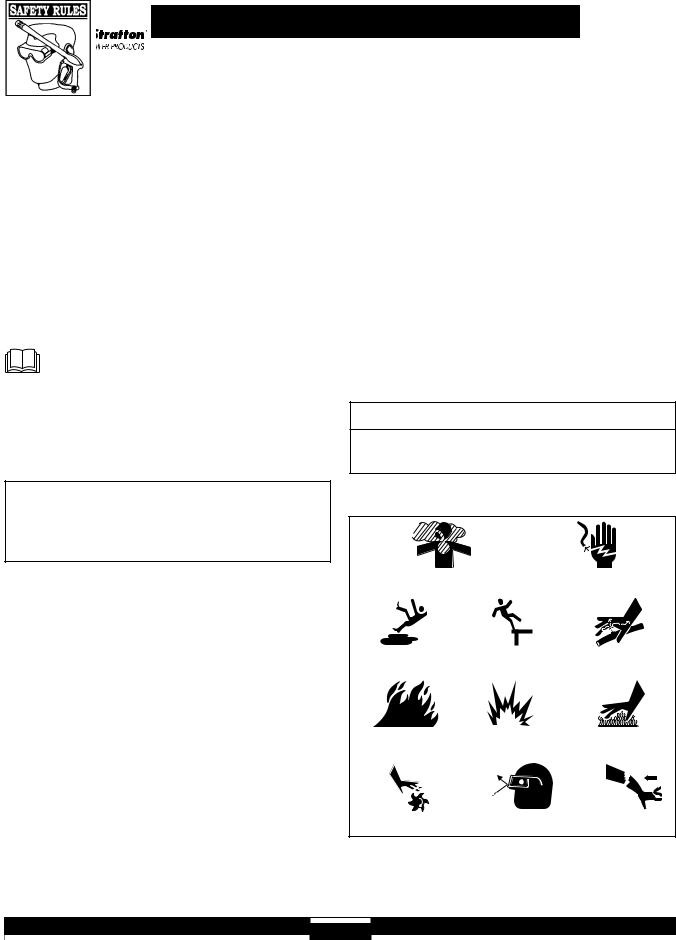
Pressure Washer
TABLE OF CONTENTS
Safety Rules. . . . . . . . . . . . . . . . . . . . . . . . . . . . . . . . . . 2-3
Assembly. . . . . . . . . . . . . . . . . . . . . . . . . . . . . . . . . . . . 4-7
Operation . . . . . . . . . . . . . . . . . . . . . . . . . . . . . . . . . . 8-10
Maintenance . . . . . . . . . . . . . . . . . . . . . . . . . . . . . . . 11-14
Storage . . . . . . . . . . . . . . . . . . . . . . . . . . . . . . . . . . . . . . 14
Notes . . . . . . . . . . . . . . . . . . . . . . . . . . . . . . . . . . . . . . . 15
Troubleshooting . . . . . . . . . . . . . . . . . . . . . . . . . . . . . . . 16
Warranty . . . . . . . . . . . . . . . . . . . . . . . . . . . . . . . . . . . . 17
EQUIPMENT
DESCRIPTION
Read this manual carefully and become familiar with your pressure washer. Know its applications, its limitations and any hazards involved.
Every effort has been made to ensure that information in this manual is accurate and current. However, we reserve the right to change, alter or otherwise improve the product and this document at any time without prior notice.
In the State of California a spark arrester is required by law (Section 4442 of the California Public Resources Code). Other states may have similar laws. Federal laws apply on federal lands. If you equip the muffler with a spark arrester, it must be maintained in effective working order.
SAFETY RULES
This is the safety alert symbol. It is used to alert you to potential personal injury hazards. Obey all safety messages that follow this symbol to avoid possible injury or death.
The safety alert symbol ( ) is used with a signal word (DANGER, CAUTION,WARNING), a pictorial and/or a safety message to alert you to hazards. DANGER indicates a hazard which, if not avoided, will result in death or serious injury. WARNING indicates a hazard which, if not avoided, could result in death or serious injury. CAUTION indicates a hazard which, if not avoided, might result in minor or moderate injury. CAUTION, when used without the alert symbol, indicates a situation that could result in equipment damage. Follow safety messages to avoid or reduce the risk of injury or death.
) is used with a signal word (DANGER, CAUTION,WARNING), a pictorial and/or a safety message to alert you to hazards. DANGER indicates a hazard which, if not avoided, will result in death or serious injury. WARNING indicates a hazard which, if not avoided, could result in death or serious injury. CAUTION indicates a hazard which, if not avoided, might result in minor or moderate injury. CAUTION, when used without the alert symbol, indicates a situation that could result in equipment damage. Follow safety messages to avoid or reduce the risk of injury or death.
 WARNING
WARNING
The engine exhaust from this product contains chemicals known to the State of California to cause cancer, birth defects, or other reproductive harm.
Hazard Symbols and Meanings
Toxic Fumes |
Electrical Shock |
Slippery Surface |
Fall |
Fluid Injection |
Fire |
Explosion |
Hot Surface |
Moving Parts |
Flying Objects |
Kickback |
2
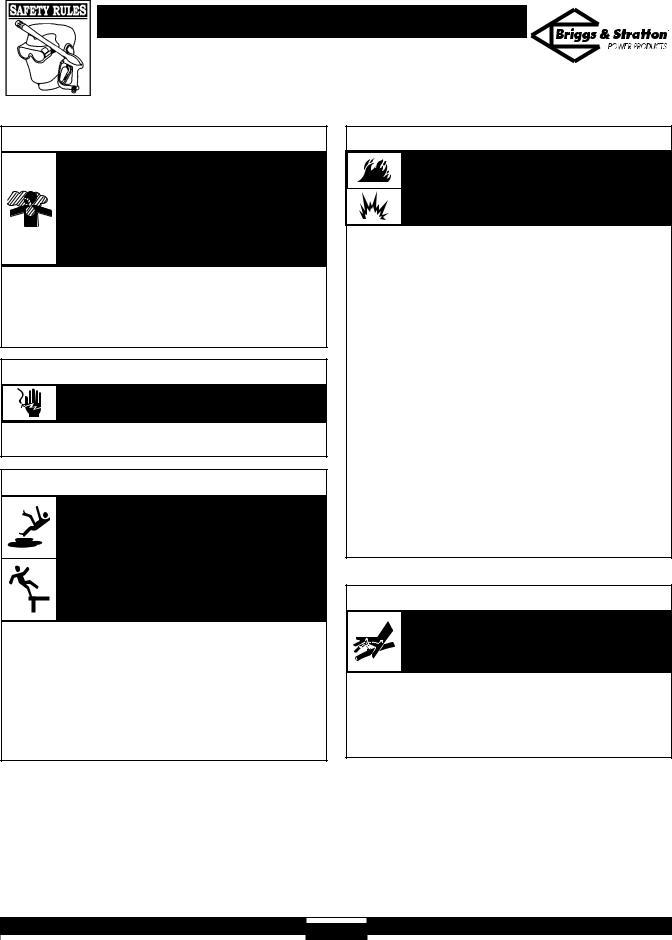
Pressure Washer
 DANGER
DANGER
Running engine gives off carbon monoxide, an odorless, colorless, poison gas.
Some chemicals or detergents may be harmful if inhaled or ingested, causing severe nausea, fainting or poisoning.
Breathing carbon monoxide will cause nausea, fainting or death.
•Operate pressure washer ONLY outdoors.
•Use a respirator or mask whenever there is a chance that vapors may be inhaled.
•Read all instructions with mask so you are certain the mask will provide the necessary protection against inhaling harmful vapors.
 WARNING
WARNING
Spray contact with electrical wiring can result in electrocution.
•Keep water spray away from electric wiring or fatal electric shock may result.
 WARNING
WARNING
Use of pressure washer can create puddles and slippery surfaces.
High pressure spray could cause you to fall if you are too close to the cleaning surface.
•Keep spray nozzle between 8 to 24 inches away from cleaning surface.
•Operate this unit on a stable surface.
•The cleaning area should have adequate slopes and drainage to reduce the possibility of a fall due to slippery surfaces.
•Be extremely careful if you must use the pressure washer from a ladder, scaffolding or any other relatively unstable location.
•Firmly grasp spray gun with both hands when using high pressure spray to avoid injury if gun kicks back.
 WARNING
WARNING
Fuel and its vapors are extremely flammable and explosive.
Fire or explosion can cause severe burns or death.
WHEN ADDING FUEL
•Turn pressure washer OFF and let it cool at least 2 minutes before removing gas cap.
•Fill fuel tank outdoors.
•DO NOT overfill tank.Allow space for fuel expansion.
•Keep fuel away from sparks, open flames, pilot lights, heat, and other ignition sources.
•DO NOT light a cigarette or smoke.
WHEN OPERATING EQUIPMENT
•DO NOT tip engine or equipment at angle which causes fuel to spill.
•DO NOT spray flammable liquids.
WHEN TRANSPORTING OR REPAIRING EQUIPMENT
•Transport/repair with fuel tank EMPTY or with fuel shutoff valve OFF.
WHEN STORING FUEL OR EQUIPMENT WITH FUEL IN TANK
•Store away from furnaces, stoves, water heaters, clothes dryers or other appliances that have pilot light or other ignition source because they can ignite fuel vapors.
 WARNING
WARNING
The high pressure stream of water that this equipment produces can pierce skin and its underlying tissues, leading to serious injury and possible amputation.
•NEVER aim spray gun at people, animals or plants.
•DO NOT allow CHILDREN to operate pressure washer.
•NEVER repair high pressure hose. Replace it.
•Keep high pressure hose connected to pump and spray gun while system is pressurized.
3
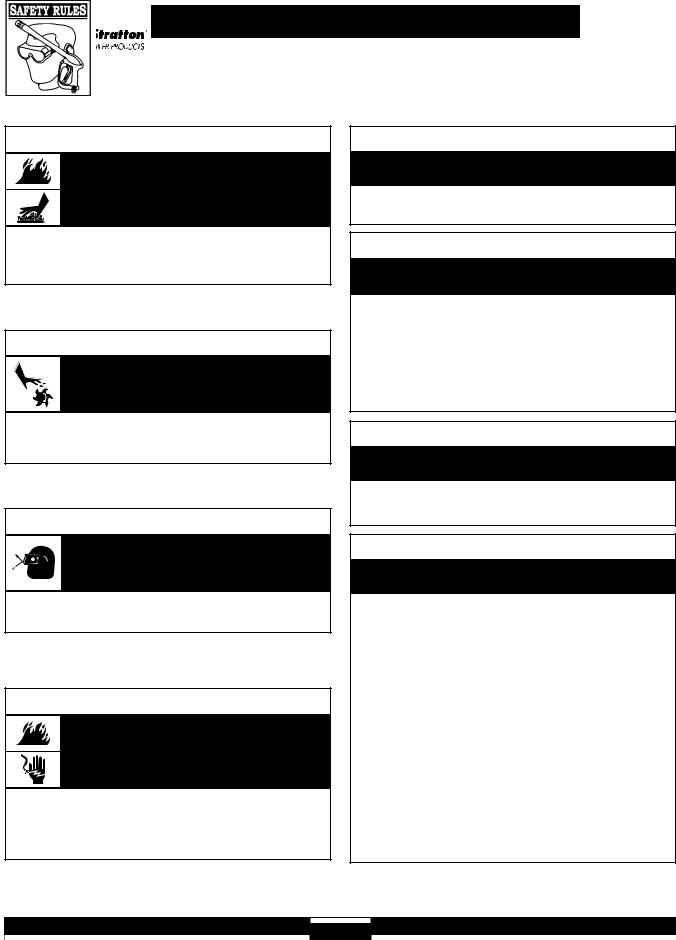
Pressure Washer
 WARNING
WARNING
Running engines produce heat and hot exhaust gases.Temperature of muffler and nearby areas can reach or exceed 150°F (65°C).
Fire or severe burns can occur.
•DO NOT touch hot surfaces.
•Stay clear of exhaust gases.
•Allow equipment to cool before touching.
 WARNING
WARNING
Starter and other rotating parts can entangle hands, hair, clothing, or accessories.
•DO NOT wear loose clothing, jewelry or anything that may be caught in the starter or other rotating parts.
•Tie up long hair and remove jewelry.
 WARNING
WARNING
High pressure spray can cause paint chips or other particles to become airborne.
•Always wear eye protection when using this equipment or in vicinity of where equipment is in use.
 WARNING
WARNING
Unintentional sparking can result in fire or electric shock.
WHEN ADJUSTING OR MAKING REPAIRS TO YOUR PRESSURE WASHER
•Disconnect spark plug wire from spark plug and place wire where it cannot contact spark plug.
 CAUTION
CAUTION
Excessively high or low operating speeds increase risk of injury and damage to pressure washer.
•DO NOT tamper with governed speed.
•DO NOT operate pressure washer above rated pressure.
 CAUTION
CAUTION
A pressure washer produces a high pressure spray which increases risk of injury and damage to unit.
•DO NOT secure spray gun in open position.
•DO NOT leave spray gun unattended while machine is running.
•NEVER use a spray gun which does not have a trigger lock or trigger guard in place and in working order.
•Always be certain spray gun, nozzles and accessories are correctly attached.
CAUTION
High pressure spray may damage fragile items including glass.
•DO NOT point spray gun at glass when in jet spray mode.
•NEVER aim spray gun at plants.
CAUTION
Improper treatment of pressure washer can damage it and shorten its life.
•If you have questions about intended use, ask dealer or contact Briggs & Stratton Power Products.
•NEVER operate units with broken or missing parts, or without protective housing or covers.
•DO NOT by–pass any safety device on this machine.
•Before starting pressure washer in cold weather, check all parts of the equipment to be sure ice has not formed there.
•NEVER move machine by pulling on high pressure hose. Use handle provided on unit.
•Check fuel system for leaks or signs of deterioration, such as chafed or spongy hose, loose or missing clamps, or damaged tank or cap. Correct all defects before operating pressure washer.
•This equipment is designed to be used with Briggs & Stratton Power Products authorized parts ONLY. If equipment is used with parts that DO NOT comply with minimum specifications, user assumes all risks and liabilities.
4
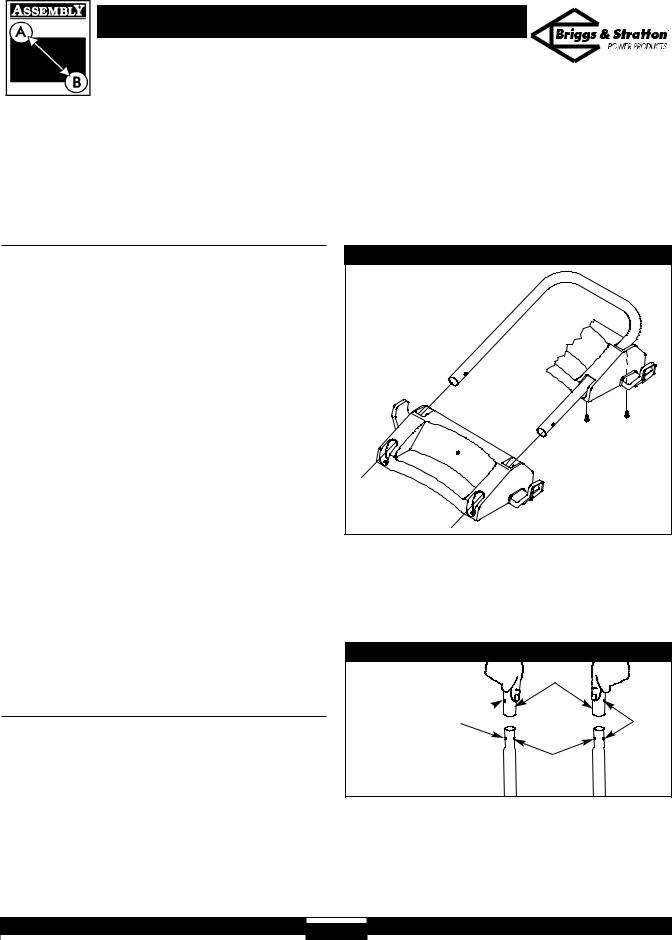
ASSEMBLY
Pressure Washer
To attach handle with accessory tray (Models 01805 and 01806):
IMPORTANT: Read entire owner’s manual before you attempt to assemble or operate your new pressure washer.
Remove Pressure Washer From
Carton
1.Remove the parts bag, accessories, and inserts included with pressure washer.
2.Slice two corners at the end of carton from top to bottom so the panel can be folded down flat.
3.Remove pressure washer from carton.
PREPARING PRESSURE WASHER FOR USE
If you have any problems with the assembly of your pressure washer or if parts are missing or damaged, call the pressure washer helpline at 1-800-743-4115. If calling for assistance, please have the model, revision, and serial number from the data tag available.
Perform these tasks to prepare unit for operation:
•Attach the handle to the main unit.
•Add oil to the engine.
•Add fuel to the fuel tank.
•Connect the high pressure hose to the spray gun and the pump.
•Connect the water supply to the pump.
•Connect nozzle extension to spray gun.
•Select and install desired nozzle (if applicable).
Attach Handle to Unit
This manual describes assembly and use of three models (01805, 01806 and 01936). Please see the appropriate section for the handle instruction specific to your model.
NOTE: All assembly operations given in this section will be described from the perspective of assembling the pressure washer from the rear.
1.Slide plastic accessory tray onto handle and align holes in accessory tray with holes on handle (Figure 1).
Figure 1 — Attach Accessory Tray
2.Secure tray to handle with self tapping screws using a #2 phillips screwdriver. Ensure screws are tight but not crushing the plastic accessory tray.
3.Place handle assembly onto handle supports connected to main unit. Make sure holes in handle align with holes on handle supports (Figure 2).
Figure 2 — Attach Handle to Base
Handle
Align Holes 
Handle
Supports
NOTE: It may be necessary to move handle supports from side to side in order to align handle so it will slide over handle supports.
5

Pressure Washer
4.Insert “L” bolt through hole on left side of handle (viewing from rear of unit) and attach plastic knob. Tighten knob by hand (Figure 3).
Figure 3 — Secure Handle
5.Insert carriage bolt through right side hole from outside of unit and attach plastic knob from inside of unit (viewing from rear of unit).Tighten by hand (Figure 3).
6.Insert “J” hook into second from left slot in accessory tray (Figure 4).
7.Pinch chemical hose and slide it into metal clip as shown in Figure 5.
Figure 5 — Slide Chemical Hose into Metal Clip
8.Tilt unit up by handle and attach metal clip to rib on center underside of accessory tray (Figure 6). Slide chemical hose through metal clip so that it is tight but not kinked.
|
|
Figure 6 — Slide Metal Clip onto Accessory Tray Flange |
Figure 4 — Install “J” Hook on Accessory Tray |
|
|
|
|
|
|
|
|
|
|
|
6
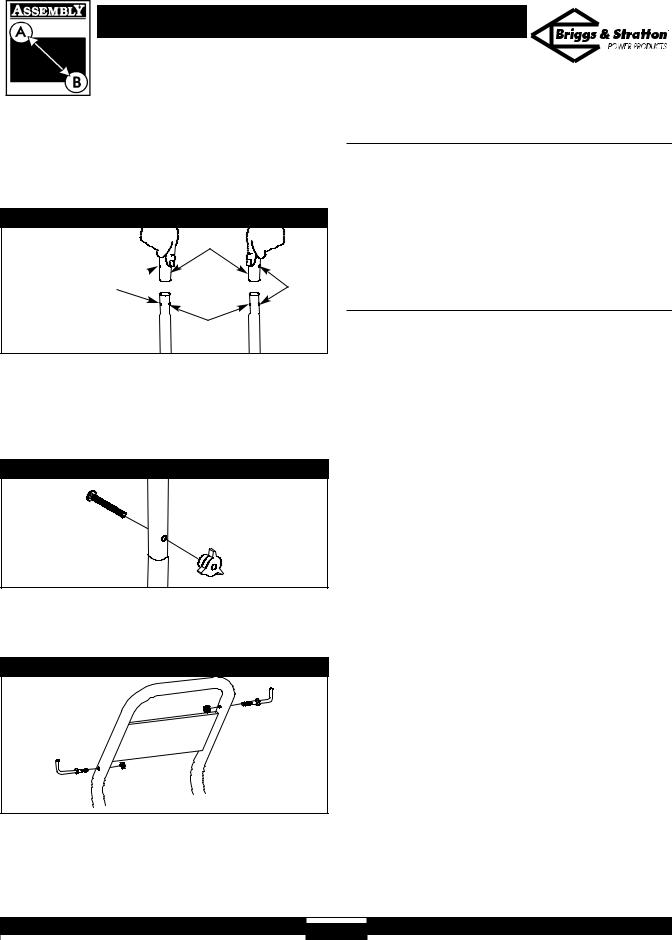
Pressure Washer
To attach handle supplied with two “L” hooks (Model 01936):
1.Place handle assembly onto handle supports connected to main unit. Make sure holes in handle align with holes on handle supports (Figure 7).
Figure 7 — Attach Handle to Base
Handle
Align Holes 
Handle
Supports
NOTE: It may be necessary to move the handle supports from side to side in order to align the handle so it will slide over the handle supports.
2.Insert carriage bolts through holes from outside of the unit and attach a plastic knob from inside of unit (Figure 8).Tighten by hand.
Figure 8 — Secure Handle
3.Insert one “L” hook through hole just under billboard on left side of handle (viewing from rear of unit). Hold hook in place with pliers and attach locknut with 7/16” wrench (Figure 9).
Figure 9 — Attach “L” Hooks to Handle
Spray Gun
Hook
Hose Hook
Add Engine Oil
IMPORTANT: Any attempt to crank or start the engine before it has been properly serviced with the recommended oil may result in an engine failure.
•Place pressure washer on a level surface.
•Refer to engine owners manual to add recommended oil to engine.
NOTE: Check Oil Often During Engine Break–in.
Add Fuel
 WARNING! NEVER fill fuel tank indoors. NEVER fill fuel tank when engine is running or hot.Allow unit to cool for two minutes before refueling. DO NOT light a cigarette or smoke when filling the fuel tank.
WARNING! NEVER fill fuel tank indoors. NEVER fill fuel tank when engine is running or hot.Allow unit to cool for two minutes before refueling. DO NOT light a cigarette or smoke when filling the fuel tank.
 WARNING! DO NOT overfill the fuel tank. Always allow room for fuel expansion.
WARNING! DO NOT overfill the fuel tank. Always allow room for fuel expansion.
•Place pressure washer on a level surface.
•Refer to engine owners manual to add recommended fuel to engine.
4.Insert other “L” hook through hole just above billboard on right side of handle (viewing from rear of unit). Hold hook in place with pliers and attach locknut with 7/16” wrench (Figure 9).
7
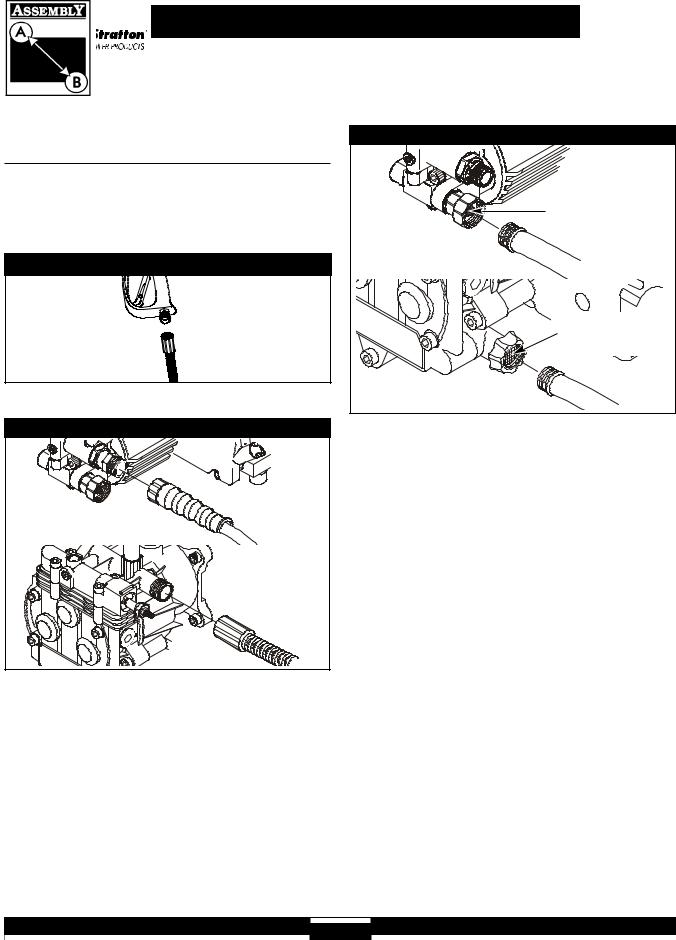
Pressure Washer
Connect Hose and Water Supply to Pump
IMPORTANT: To avoid pump damage, you must assemble the nozzle extension to the spray gun and attach all hoses before you start the engine.
1.Uncoil high pressure hose and attach one end of hose to base of spray gun (Figure 12).Tighten by hand.
Figure 12 — Connect High Pressure Hose to Spray Gun
2.Attach other end of high pressure hose to high pressure outlet on pump (Figure 13).Tighten by hand.
Figure 13 — Connect High Pressure Hose to Pump |
Model 01806 |
OR |
Model 01805 |
and 01806 |
3.Before connecting garden hose to water inlet, inspect inlet screen (Figure 14). Clean screen if it contains debris or replace if damaged. Refer to “O-Ring Maintenance” section on page 13 if inlet screen is damaged. DO NOT run pressure washer if inlet screen is damaged.
4.Run water through your garden hose for 30 seconds to clean out any debris.
IMPORTANT: DO NOT siphon standing water for the water supply. Use ONLY cold water (less than 100°F).
5.Connect garden hose (not to exceed 50 feet in length) to water inlet.Tighten by hand (Figure 14).
Figure 14 — Connect the Garden Hose to Water Inlet
Inspect inlet screen, |
DO NOT use if |
damaged, clean if dirty. |
Model 01806 |
OR |
Inspect inlet screen, |
DO NOT use if |
damaged, clean if dirty. |
Model 01805 and 01936 |
CAUTION! There MUST be at least ten feet of unrestricted garden hose between the pressure washer inlet and any flow shut off device, such as a ‘Y’ shut-off connector or other convenience-type water shut-off valve. Damage to pressure washer resulting from disregarding this warning will not be covered by the warranty.
6.Turn ON water and squeeze trigger on gun to purge pump system of air and impurities.
 CAUTION! Before starting the pressure washer, be sure you are wearing adequate eye protection.
CAUTION! Before starting the pressure washer, be sure you are wearing adequate eye protection.
CHECKLIST BEFORE STARTING ENGINE
Review the unit’s assembly to ensure you have performed all of the following.
1.Make sure handle is in place and secure.
2.Check that oil has been added to proper level in engine crankcase.
3.Add proper fuel to fuel tank.
4.Check for properly tightened hose connections.
5.Check to make sure that there are no kinks, cuts, or damage to the high pressure hose.
6.Provide a proper water supply at an adequate flow.
7.Be sure to read “Safety Rules” and “How To Use Your Pressure Washer” before using the pressure washer.
8
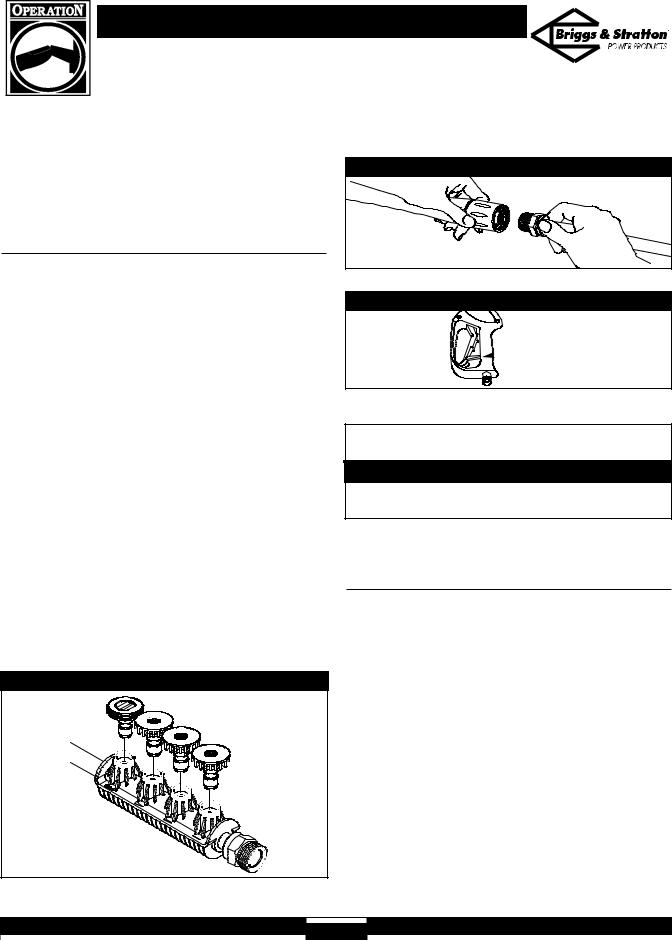
Pressure Washer
HOW TO USE YOUR
7.On all models, attach nozzle extension to spray gun (Figure 16).Tighten by hand.
PRESSURE WASHER
If you have any problems operating your pressure washer, please call the pressure washer helpline at 1-800-743-4115.
How to Start Pressure Washer
To start your pressure washer for the first time, follow these instructions step-by-step.This starting information also applies if you have let the pressure washer sit idle for at least a day.
1.Place pressure washer near an outside water source capable of supplying water at a flow rate greater than 1.0 gallons per minute more than pressure washer is rated for and no less than 20 PSI at pressure washer end of garden hose.
2.Check that high pressure hose is tightly connected to spray gun and pump. See “Preparing Pressure Washer for Use” for illustrations.
3.Make sure unit is in level position.
4.Connect garden hose to water inlet on pressure washer pump. Turn ON water.
CAUTION! DO NOT run the pump without the water supply connected and turned on.You must follow this caution or the pump will be damaged.
5.Squeeze spray gun trigger until a steady stream of water occurs.
6.For models 01806 and 01936, place quick connect spray tips in slots on the holder attached to nozzle extension (Figure 15).
Figure 15 — Install Spray Tips in Holder
Figure 16 — Connect Nozzle Extension to Spray Gun
8.Engage safety latch to spray gun trigger (Figure 17).
Figure 17 — Spray Gun with Safety Latch Engaged
 Safety Latch
Safety Latch
9.Start engine according to instructions given in engine owner’s manual.
 CAUTION
CAUTION
Avoid injury from kickback.
•Squeeze trigger on spray gun each time recoil starter is pulled and engine fails to start.
NOTE: Always keep the throttle lever in the “Fast” position when operating the pressure washer.
How to Stop Pressure Washer
1.Let engine idle for two minutes.
2.Turn engine off according to instructions given in engine owner’s manual.
3.Squeeze trigger on spray gun to relieve pressure in hose.
NOTE: A small amount of water will squirt out when pressure is released.
HOW TO USE NOZZLES
You now should know how to START your pressure washer and how to STOP it.This section tells you how to adjust the spray pattern.
 WARNING! NEVER adjust spray pattern when spraying. NEVER put hands in front of nozzle to test spray pattern.
WARNING! NEVER adjust spray pattern when spraying. NEVER put hands in front of nozzle to test spray pattern.
9
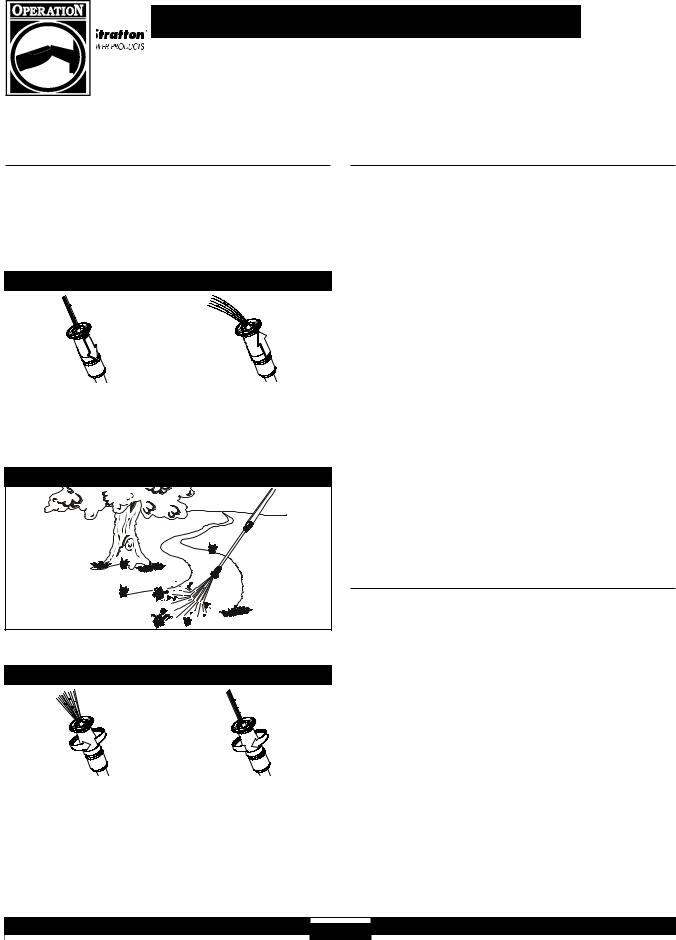
Pressure Washer
If Unit is Equipped with Adjustable Nozzle
If your pressure washer is equipped with an adjustable nozzle (Model 01805 (2500 PSI)), adjust the spray pattern and spray pressure as follows:
1.Slide nozzle forward to obtain low pressure mode (Figure 18). Slide nozzle backward to achieve high pressure.
Figure 18 — Adjusting Nozzle for Pressure
Slide nozzle backward |
Slide nozzle forward for low |
for High Pressure Mode |
pressure mode and |
|
detergent application |
2.Point nozzle towards firm surface and press trigger to test spray pattern (Figure 19).
Figure 19 — Testing the Spray Pattern
3.Twisting nozzle adjusts spray pattern from narrow pattern to fan pattern (Figure 20).
Figure 20 — Adjusting the Nozzle for Spray Pattern
Rotate nozzle |
Rotate nozzle clockwise |
counterclockwise for fan |
for narrow spray pattern |
spray pattern |
|
4.For most effective cleaning, keep spray nozzle from 8 to 24 inches away from cleaning surface.
5.DO NOT get closer than 6 inches when cleaning automobile tires.
If Unit is Equipped with Quick-Connect Spray Tips
 CAUTION! NEVER exchange nozzles without locking the safety latch on the trigger.
CAUTION! NEVER exchange nozzles without locking the safety latch on the trigger.
NOTE: Model 01805 (2500 PSI) is NOT equipped with quick connect spray tips.
The nozzle extension quick–connect allows the use of several different spray tips. Each spray tip provides a different spray pattern.
Follow these instructions to change spray tips:
1.Engage safety latch on spray gun.
2.Pull back collar on quick–connect and pull current spray tip off.
3.Select desired spray tip:
•For gentle rinse, select white 40° spray tip.
•To scour surface, select yellow 15° or red 0° spray tip.
•To apply chemical, select black spray tip.
4.Pull back on collar, insert new spray tip and release collar. Tug on spray tip to make sure it is securely in place.
5.For most effective cleaning, keep spray tip from 8 to 24 inches away from cleaning surface. DO NOT get closer than 6 inches when cleaning automobile tires.
Cleaning and Applying Chemical
IMPORTANT: Use soaps designed specifically for pressure washers. Household detergents could damage the pump.
To apply detergent follow these steps:
1.Review the use of nozzles.
2.Prepare detergent solution as required by manufacturer.
3.Place chemical injection siphon/filter into detergent container.
CAUTION! Keep the chemical injection tube from coming in contact with the hot muffler.
4A. For model 01805, slide adjustable nozzle forward to low pressure mode. Detergent cannot be applied with nozzle in high pressure position.
4B. For models 01806 and 01936, make sure black spray tip is installed. Detergent cannot be applied with high pressure quick-connect spray tips (White,Yellow, or Red).
10
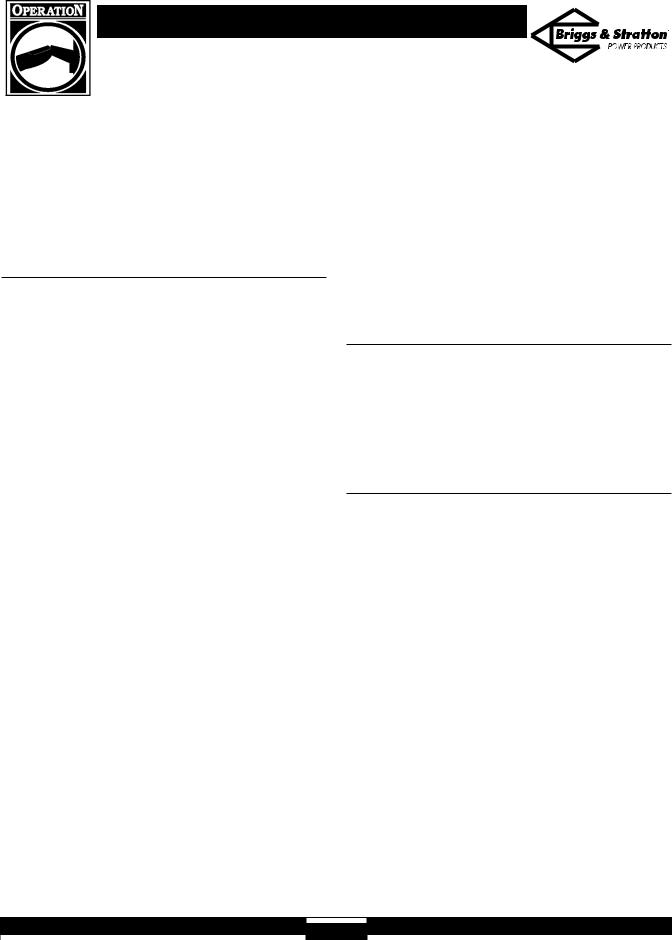
Pressure Washer
5.Apply detergent to a dry surface, starting at lower portion of area to be washed and work upward, using long, even, overlapping strokes. DO NOT allow detergent to dry on (prevents streaking).
6.Allow detergent to soak in between 3–5 minutes before washing and rinsing. Reapply as needed to prevent surface from drying.
Pressure Washer Rinsing
 WARNING! Be extremely careful if you must use the pressure washer from a ladder, scaffolding or any other relatively unstable location.When you press the trigger, the recoil from the initial spray can be very strong.The high pressure spray could cause you to fall if you are too close to the cleaning surface.
WARNING! Be extremely careful if you must use the pressure washer from a ladder, scaffolding or any other relatively unstable location.When you press the trigger, the recoil from the initial spray can be very strong.The high pressure spray could cause you to fall if you are too close to the cleaning surface.
After you have applied detergent, scour the surface with the high pressure water stream and then rinse it clean, as follows:
1.Apply safety latch to spray gun.
2.Slide nozzle backwards or insert high pressure quick connect spray tip to place pressure washer in high pressure mode. Chemical will not flow when in high pressure mode.
3.Keep spray gun a safe distance from spray area.
4.Disengage safety latch on spray gun.
 CAUTION! Firmly grasp spray gun with both hands when using high pressure spray to avoid injury if gun kicks back.
CAUTION! Firmly grasp spray gun with both hands when using high pressure spray to avoid injury if gun kicks back.
5.Expand spray pattern or select white 40° quick connect spray tip for a more gentle rinsing action. Start at top of area to be rinsed, working down with same action as for cleaning.
CAUTION! Test a small area of the surface to be cleaned. Make sure there is no damage caused by the high pressure spray.
Cleaning Detergent Siphoning Tube
1.Place chemical injection siphon/filter in bucket full of clean water.
2.Attach black low pressure spray tip or slide adjustable nozzle forward to low pressure mode.
3.Flush for 1-2 minutes.
Automatic Cool Down System
(Thermal Relief)
If you run the engine on your pressure washer for
3-5 minutes without pressing the trigger on the spray gun, circulating water in the pump can reach temperatures above 125°F.The system engages to cool the pump by discharging the warm water onto the ground.
11
